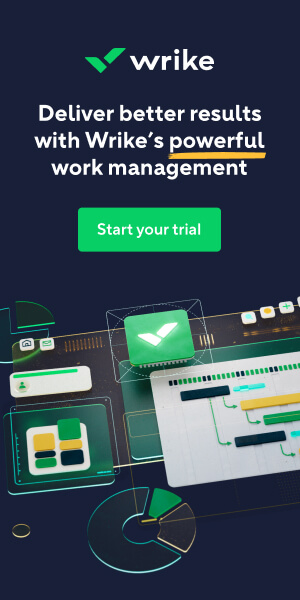Establishing individual roles and responsibilities is a critical component of any project manager’s job. Not only does it give the project team members a better understanding of what’s expected from them, but it makes it easy for project stakeholders to track progress and measure success.
But, this process is easier said than done. When overseeing projects with dozens or even hundreds of team members, it’s impossible to keep track of all of this information without some sort of chart or spreadsheet — and that’s exactly where the DACI and RACI models begin to shine.
Featured Partners: Project Management Software
What is the DACI Model?
The DACI model is a decision-making framework that establishes authority over the various elements of a project. With a DACI matrix, project participants are assigned one of four letters to determine their impact on key decisions.
- D: The driver is the one who is responsible for making the final decision regarding a particular course of action.
- A: Next in the chain of authority is the approver, who is responsible for approving decisions that pertain to the project.
- C: These individuals are responsible for contributing to a decision. However, they don’t have the authority to influence the final decision in any way.
- I: Individuals with the least amount of authority are the informed participants. While they need to be informed of the final decision, they have no influence in actually making the decision.
In most cases, there is a single driver for each one of the project’s elements. However, different drivers can be assigned to different aspects of the same project. Individuals can also have multiple assignments across the DACI matrix.
While it’s usually the project manager’s job to decide on the overall vision of the project, for example, it’s generally the quality assurance team that decides when to release the product or when to delay it. However, the project manager might have the responsibility of approving or denying their decision.
Although engineers and scrum masters are usually tasked as drivers when it comes to adding and organizing sprints, they have little or no input on the overall direction or scope of the project itself. It’s this looping chain of authority that is tracked within the DACI matrix.
For best results, try to stick with one driver for each element of the project. The overall number of approvers should be kept at a minimum, too, as this reduces the chance of internal conflict. Regardless of the scope of the project, most team members should be designated as contributors or informed participants.
Creating a DACI matrix
Designing a DACI matrix is a straightforward process. It’s a simple table that lists the individual elements of a project alongside the left side and the different job titles, roles, or departments involved with the project along the top.
Start by determining the exact decisions that need to be made throughout the project life cycle. Break these down into individual tasks to fill in the left side of your DACI matrix. Next, define the various roles, or team members, involved in the project. These roles are listed along the top of your DACI chart.
From there, work through the resulting list of project tasks and fill in the DACI assignments for each specific role. Depending on the scope and scale of the project, this process could take a considerable amount of time to complete. The added organization and efficiency, however, is well worth the time and effort.
When to use the DACI model
The DACI model is often seen in industries like software development, product development, and any profession that works on a per-project basis. More specifically, it’s designed to drive the decision-making process and make day-to-day activities as efficient as possible for project stakeholders.
When staff members have difficulty making key decisions, or if project participants are confused about their exact assignments, the DACI model is the ideal approach. Although it lacks integrated quality assurance, DACI provides a clear chain of authority that is easily traceable by internal and external stakeholders alike.
Advantages and disadvantages of the DACI model
The fact that the DACI matrix utilizes a single driver for each element, task, or activity within the project is its biggest selling point. However, there are numerous drawbacks to consider when using the DACI model.
In some ways, DACI is a paradox. While the DACI matrix ultimately dictates who makes the decisions and who gets to approve them, these individuals need to be assigned before any project-specific decisions are actually made. For a novice project manager (PM), or a PM working with a new or inexperienced team, many of the individual assignments are based on guesswork.
While this isn’t such an issue with PMs who are used to working with the same teammates, assigning DACI roles based on guesswork can cause a myriad of problems.
- Any decisions that require clarification or escalation can be slow and challenging to resolve.
- Executives who are assigned as approvers might show bias when it comes to approving or rejecting decisions.
- Decisions are sometimes categorized or standardized in a low-effort manner to meet role-specific requirements.
These drawbacks alone shouldn’t be the deciding factor in the DACI versus RACI debate. Instead, efficient and effective project managers should consider these limitations and apply them when creating their DACI matrixes.
What is the RACI Model?
Although it’s a similar concept, RACI is used for a different purpose than DACI. It also provides different results when applied to project management.
- R: These individuals are responsible for completing certain tasks or actions.
- A: These individuals are accountable for verifying the completion of tasks, actions, and activities.
- C: Consulted individuals are those who have direct input in the completion of tasks and activities.
- I: Informed participants are project stakeholders who aren’t directly involved in the project.
Whereas DACI takes a decision-based approach to project management, RACI puts more of an emphasis on individual responsibilities. Both models are ultimately used to achieve the same purpose, and when implemented correctly, they have significant benefits.
Unlike DACI, however, which relies on one driver per project element, RACI actually permits multiple responsible parties per task, activity, or element within the project. For example, the entire project team might be responsible for attending daily meetups, scrums, or sprints. But when it comes to developing the overall project vision, most of these team members would be designated as informed participants.
Likewise, the entire project team would need to be aware and informed of any quality assurance requirements or expectations, so they’d all be distinguished with an I. However, only those assigned to the quality assurance department would play a part in creating and establishing these requirements. As such, they would be considered responsible parties and marked with an R in the RACI matrix.
But, the rules of the RACI matrix dictate that each participant should only have one responsibility type at a time. An individual team member or department can be responsible for a single project deliverable and a certain activity, for example, but they shouldn’t be responsible for producing two or more project deliverables or activities within the same project.
Creating a RACI matrix
The creation of a RACI matrix is virtually identical to that of a DACI matrix. Project-specific tasks are listed down the left side while Individual roles and departments are detailed across the top of the chart. The cells in the resulting matrix are easily filled in with the assignments that correspond to the individual project tasks and roles.
Instead of focusing on decisions to be made and the individual decision-makers, the RACI matrix determines who is directly responsible for completing each task. This is the key difference between DACI and RACI, and it’s critical when determining which approach to use.
When to use the RACI matrix
Also used in a variety of industries and projects, RACI is most useful when the decision-making process is divided between multiple tasks. It’s also useful when trying to boost engagement amongst project participants and stakeholders, as everyone understands exactly what is expected from them.
Advantages and disadvantages of the RACI model
The RACI model is extremely beneficial when implemented correctly. It provides numerous advantages to project team members, including:
- Tracking project deliverables and providing transparency
- Clarifying any additional staff training that may be needed based on RACI assignments
- Making it easier to escalate issues to those with greater levels of responsibility
Like the DACI model, there are some drawbacks to consider before committing to the RACI approach:
- Lack of a single decision-maker makes it difficult to produce a final decision that everyone can agree on.
- Responsible parties might feel underqualified to make critical decisions, ultimately resulting in escalation and wasted time.
- Stakeholders and participants can become confused regarding the kind of input that is required and when it should be delivered.
Understanding these pitfalls before beginning a project can help project managers determine if RACI is the right approach. If neither DACI or RACI meets the project’s needs, there are some alternative frameworks to consider.
Alternatives in the DACI vs. RACI Debate
There is much debate about the topic of DACI versus RACI. However, these aren’t the only two project management frameworks available. Many others are used, either for specialized projects or in various industries, and some are more popular than others.
Some alternative frameworks that are similar to DACI include:
- ARCI (Approve, Recommend, Consulted, Informed): This method moves the approver into the forefront. Use this method when establishing individual decision-making rights.
- PACSI (Perform, Accountable, Control, Suggest, Inform): The PACSI model centers on the person who is required to complete the specific task or element. It’s been used when collecting input from multiple stakeholders.
- RAPID (Recommend, Agree, Perform Input, Decision): Whereas the first letter in most methodologies represents the key decision-maker of a task or element, the RAPID model takes the opposite approach.
Other alternatives are direct offshoots of the RACI model:
- RACIQ (Responsible, Accountable, Consulted, Informed, Quality): This model simply adds the Q (quality) designation to the traditional RACI model. It’s used to ensure quality assurance and review within the project.
- RACI-VS (Responsible, Accountable, Consulted, Informed, Verifier, Signatory): This model represents traditional RACI with the addition of a verifier and signatory, both of which also play key roles in quality control.
- RASCI or RASI (Responsible, Accountable, Support, Consulted, Informed): Adding built-in project support is ideal for projects that don’t require consultants, such as the case with RASI, or whenever additional support is needed for project tasks.
- RATSI (Responsibility, Authority, Task, Support, Informed): The implementation of the authority designation in RATSI makes it similar in execution to the DACI model.
Featured Partners: Project Management Software
1 Jira
Simple and powerful way to track and manage issues. It handles all kinds of issues (bugs, features, enhancements, and tasks) and can be used for bug tracking, development help, project management, or group task cataloging.
2 Trello
Organize anything, together. Trello is a collaboration tool that organizes your projects into boards. In one glance, know what’s being worked on, who’s working on what, and where something is in a process.
DACI or RACI: Which One is Right for You?
There’s no right or wrong answer regarding the choice of project management frameworks. Although some are better-suited in certain applications than others, they all have viable uses when leading various projects.
Determining the best approach to any given project is an art form that can only be mastered over the course of time. In some cases, a combination of DACI, RACI, and their alternatives are used together. While this can be a lot to track when managing large projects, taking the time to map out individual roles and responsibilities at the start of a project can spare the team from unnecessary confusion and lost productivity throughout the entire project life cycle.
Once established, DACI, RACI, and the alternative models can be reused for future projects, especially if the team members have stayed the same. By creating RACI and DACI model templates, project managers can save a lot of time when it comes to organizing new projects.
However, it’s still important to choose the model that provides the best approach for the project at hand. Just because you’ve had success with DACI in the past doesn’t necessarily mean that a DACI template is the right approach for every project in the future.
Taking a Structured Approach to Project Management
Large-scale projects always require a structured approach. While the DACI model is used to clarify the decision-making process and establish a chain of authority, the RACI model makes it easy for project managers to assign various levels of responsibility and track accountability across the project life cycle.
Although they are similar in many ways, the two frameworks actually result in distinct project leadership methodologies. As such, they can be used individually or in tandem with one another. It’s up to the project manager to find the right solution for the project at hand.












